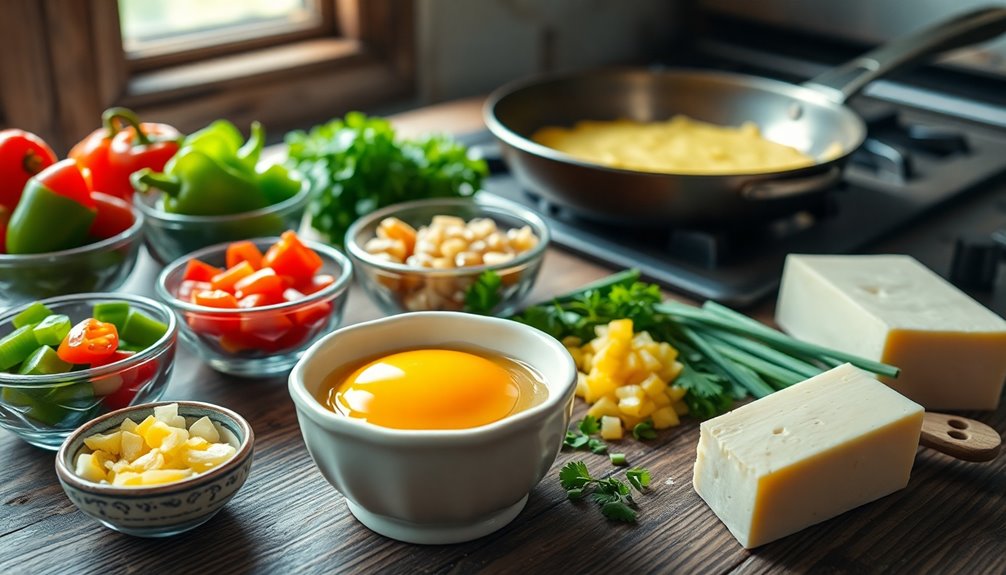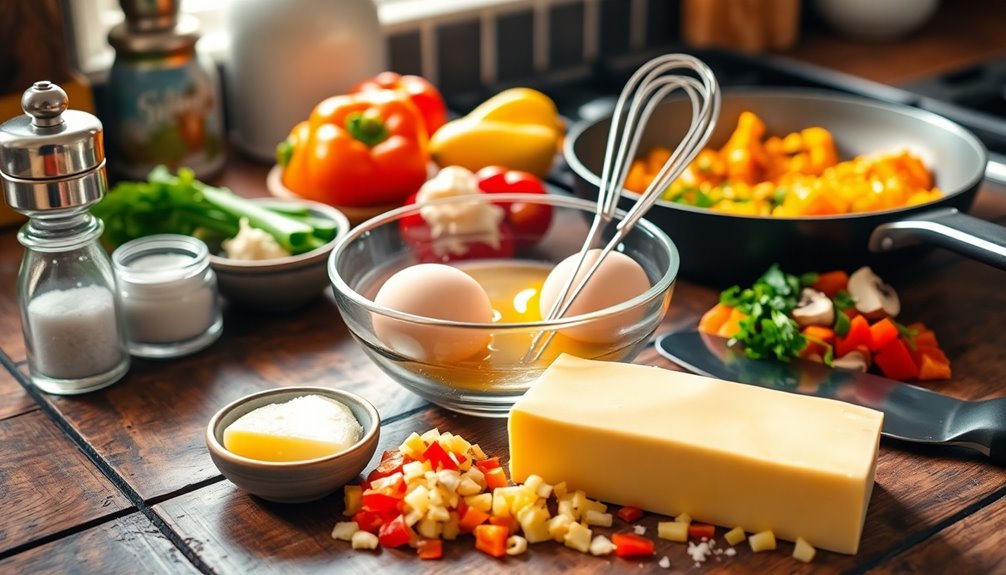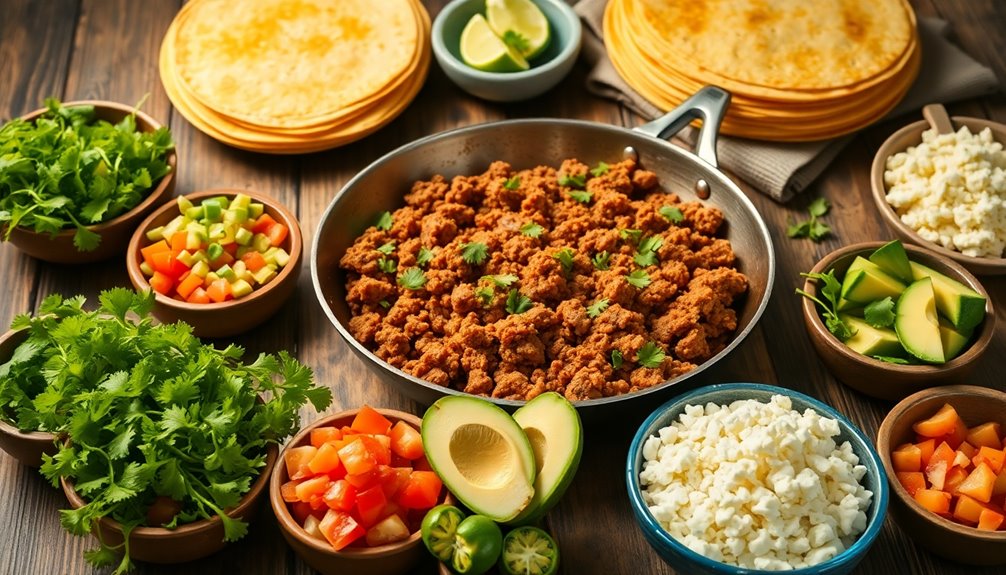To make a delicious omelette, start by whisking together 2 large eggs until frothy. Add a pinch of salt and pepper for seasoning. You can mix in 1/4 cup of cheese and your favorite diced vegetables or cooked meats. Heat a non-stick skillet over medium heat and swirl in a little butter. Pour in the egg mixture, spreading it evenly. Once the edges start to set, gently fold the omelette. Cook until it's fully cooked but still fluffy. Serve it warm, and feel free to get creative with fillings for a unique twist on this classic dish.
Key Takeaways
- Begin with 2 large beaten eggs, seasoned with salt and pepper for flavor enhancement.
- Cook the eggs in butter on medium heat to avoid browning while ensuring even cooking.
- Add desired fillings like cheese, diced vegetables, or cooked meats before folding the omelette.
- Whisk eggs thoroughly to incorporate air, resulting in a light and fluffy texture.
- Experiment with fresh herbs and varied fillings for unique taste combinations.
History

The history of the omelette is as rich and varied as the dish itself. You might be surprised to learn that its origins date back to ancient civilizations, where eggs were first cooked in simple ways.
The Greeks and Romans enjoyed variations, but it was the French who truly elevated the omelette to an art form. They introduced techniques and flavors, making it a staple in their cuisine.
As you explore different cultures, you'll find unique interpretations, from the Spanish tortilla to the Japanese tamagoyaki.
Over time, the omelette's adaptability has made it a beloved dish worldwide. It's not just breakfast; it's a canvas for creativity, reflecting local ingredients and traditions, inviting you to try new flavors and combinations.
Recipe

Omelettes are a versatile and delicious dish that can be enjoyed at any meal of the day. They're fundamentally beaten eggs cooked in a frying pan, and can be filled with a variety of ingredients such as cheese, vegetables, and meats, allowing you to customize them to your taste. Making an omelette is relatively quick and simple, making it a perfect choice for breakfast, brunch, or even a light dinner.
To achieve the perfect omelette, it's crucial to start with fresh ingredients and the right technique. The key is to cook the eggs at a moderate temperature, ensuring they remain tender and fluffy rather than rubbery. With the right balance of fillings and a little practice, you'll be able to impress your family and friends with your omelette-making skills in no time.
Ingredients:
- 2 large eggs
- Salt, to taste
- Pepper, to taste
- 1 tablespoon butter
- 1/4 cup shredded cheese (cheddar, mozzarella, or your choice)
- 1/4 cup diced vegetables (bell peppers, onions, mushrooms, or your choice)
- Optional: cooked meats (ham, bacon, or sausage)
To cook the omelette, start by cracking the eggs into a bowl and whisking them together with a pinch of salt and pepper until fully combined. Heat a non-stick skillet over medium heat and add the butter, allowing it to melt and coat the pan.
Once the butter is sizzling, pour the eggs into the skillet, tilting the pan to spread them evenly. As the edges begin to set, gently lift them with a spatula to allow the uncooked egg to flow to the edges. When the eggs are mostly set but still slightly runny on top, sprinkle your cheese, vegetables, and optional meats over one half of the omelette.
Carefully fold the other half over the fillings and let it cook for another minute or so until the cheese melts and the omelette is cooked to your desired doneness. Slide it onto a plate and serve immediately.
Extra tips for making a great omelette include using room temperature eggs for better fluffiness and being mindful of the cooking time to prevent overcooking. Don't be afraid to experiment with different fillings and seasonings to find your favorite combination.
A sprinkle of fresh herbs, like chives or parsley, can elevate the flavor, and serving the omelette with a side of toast or salad can make for a well-rounded meal. Enjoy your omelette-making adventure!
Cooking Steps

Now that you've got your ingredients ready, it's time to start cooking your omelette.
First, you'll whisk the eggs thoroughly and season them with salt and pepper.
Then, you can add your favorite cheese or vegetables before cooking on medium heat.
Step 1. Whisk Eggs Thoroughly

Whisking eggs thoroughly is essential for achieving a light and fluffy omelette. Start by cracking the desired number of eggs into a mixing bowl.
Use a fork or a whisk to beat the eggs vigorously. You want to incorporate as much air as possible, which helps create that airy texture. Whisk until the yolks and whites are completely blended, and the mixture appears slightly frothy. This should take about 1-2 minutes.
If you're feeling adventurous, you might even try a hand mixer for a quicker result. Remember, the more air you incorporate, the fluffier your omelette will be.
Once you've achieved the right consistency, you're ready for the next steps in creating your perfect dish!
Step 2. Add Salt and Pepper

After achieving that light and frothy egg mixture, it's time to enhance the flavor.
Grab your salt and pepper, and sprinkle a pinch of each into the eggs. Be mindful not to overdo it; you can always adjust later.
Use a fork or whisk to gently mix in the seasoning, ensuring it's evenly distributed throughout the eggs. This step is essential as it sets the foundation for the overall taste of your omelette.
Salt will bring out the eggs' natural richness, while pepper adds a hint of warmth.
Once you've blended the salt and pepper, you're ready to move on to the next step of cooking your omelette.
Enjoy the process and savor the anticipation!
Step 3. Add Cheese or Vegetables

As you prepare to elevate your omelette, consider adding cheese or vegetables to create a delicious and satisfying filling.
Start by choosing your favorites—sharp cheddar, creamy feta, or gooey mozzarella work wonders. For vegetables, think bell peppers, spinach, or mushrooms; they'll add flavor and texture.
Once you've selected your ingredients, chop them into bite-sized pieces. If you're using vegetables, sauté them in a little olive oil until they're tender, then sprinkle them evenly over the eggs.
Next, add a generous handful of cheese on top. Make certain to distribute everything evenly to guarantee every bite is packed with flavor.
Mixing these ingredients into your omelette will enhance its taste and nutritional value, making it truly irresistible.
Step 4. Cook on Medium Heat

Once your ingredients are prepped and ready, it's time to cook your omelette over medium heat.
Place a non-stick skillet on the stove and add a small amount of butter or oil, allowing it to melt and coat the pan evenly.
Once the pan's hot but not smoking, pour in your egg mixture. You'll want to gently swirl the pan to spread the eggs evenly.
As the edges begin to set, use a spatula to lift them slightly, letting the uncooked eggs flow underneath.
Keep an eye on the omelette, ensuring it cooks evenly without browning too much.
This process usually takes about 3-5 minutes, depending on your stove.
Enjoy the aroma as your omelette cooks to perfection!
Step 5. Fold Omelette Gently

Gently lift one edge of the omelette with your spatula and fold it over the filling. Make sure to do this slowly to prevent tearing.
You want a nice, smooth fold that encapsulates your ingredients without spilling them out. Once folded, let it cook for another minute or so, allowing the heat to meld the flavors together.
If you prefer a runny center, keep it on the stove for a shorter time; for a firmer omelette, let it cook a bit longer.
When it's ready, slide the omelette onto a plate, seam side down. Garnish with herbs or a sprinkle of cheese if you like. Enjoy your perfectly folded omelette!
Final Thoughts

While you may think making an omelette is a simple task, the possibilities for creativity and flavor are endless. Once you master the basic technique, you can experiment with various ingredients to suit your taste.
Whether you prefer classic fillings like cheese and herbs or want to explore bold flavors like spicy chorizo or sautéed mushrooms, the choice is yours. Don't shy away from trying new combinations; you might discover a new favorite!
Remember, practice makes perfect. Each omelette you create helps you refine your skills and boosts your confidence in the kitchen.
Frequently Asked Questions
Can I Use Egg Substitutes for an Omelette?
Absolutely, you can use egg substitutes for your dish!
Many people opt for alternatives like tofu, chickpea flour, or commercial egg replacers to achieve a similar texture. Just remember to adjust your cooking times and methods accordingly.
If you're using tofu, crumbling it can give you that fluffy feel. Experiment with spices and vegetables to enhance the flavor.
You'll find that it's just as satisfying without traditional eggs!
What Are the Best Fillings for a Vegetarian Omelette?
When you're making a vegetarian omelette, consider fillings like fresh spinach, diced tomatoes, and sautéed mushrooms for a burst of flavor.
Add some bell peppers and onions for crunch and color.
Feta cheese or shredded mozzarella can enhance the taste, while herbs like basil or chives give it a fresh kick.
Don't forget avocado slices for creaminess!
Mix and match to find your favorite combination that suits your palate.
How Can I Make a Fluffy Omelette?
To make a fluffy omelette, start by whisking your eggs vigorously until they're well combined and a bit frothy. This introduces air, which helps with fluffiness.
Use a non-stick skillet over medium heat and melt a little butter. Pour in the eggs and gently stir with a spatula, allowing the uncooked egg to flow to the edges.
Once it sets, fold it in half and let it cook for another minute. Enjoy!
What Cooking Oil Is Best for Omelettes?
When it comes to cooking oil, you'll want something that enhances flavor and withstands heat.
Olive oil's a great choice for its health benefits and taste, while butter adds richness. If you prefer a neutral option, canola or avocado oil works well too.
Just remember to heat the oil properly before adding your ingredients, so your dish turns out perfectly.
Experiment with different oils to find your favorite!
Can I Prepare an Omelette in Advance?
Yes, you can prepare an omelette in advance!
Just cook it fully, then let it cool before wrapping it tightly in plastic wrap or storing it in an airtight container.
When you're ready to eat, reheat it in a microwave or on the stovetop until it's warmed through.
It's a great way to save time on busy mornings, and you can even customize it with your favorite fillings!
Enjoy!










